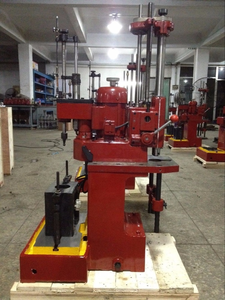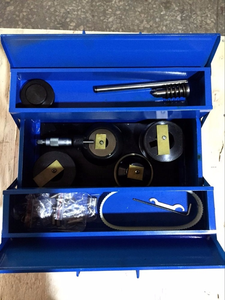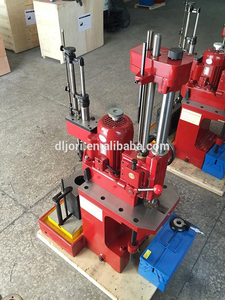
All categories
Featured selections
Trade Assurance
Buyer Central
Help Center
Get the app
Become a supplier

(14330 products available)






A honing machine is a specialized tool for accomplishing quality, precision control of bore or internal surfaces by eliminating small quantities of material. Several honing processes exist, each adapted for a specific application or type of material.
Vertical honing machines
Vertical honing machines are used to make internal cylindrical forms through precise material removal by means of a controlled number of strokes in a specified honing liquid. These machines are built for the vertical hole honing of workpieces with large lengths in relationship to their bores. They are ideal for creating high-precision holes in such pieces as hydraulic cylinders, bore diameters ranging from 15 to 120 mm, and working lengths of up to 1500 mm. Users can choose the stroke length as well as the number of honing strokes, controlled by an electronic PLC.
Horizontal honing machines
A horizontal honing machine relies on the same honing principle, yet it is useful for workpieces with horizontal bores or holes. An advantage of horizontal honing machines over vertical ones is that they can be used to hone large workpieces with respect to their length in a convenient manner. Also, horizontal honing machines feature automatic and simultaneous workpiece handling in all the honing head spindles. Operating of such machines is also simple and easy. The number of spindle holders as well as the honing parameters can be easily programmed by means of an electronic PLC.
Flexible honing machines
Flexible honing machines can adapt to a wide variety of bore shapes -including straight, taper, step, blind and through holes- as well as bore diamres ranging from 2 to 60 mm in a single honing tool. Moreover, they can adjust to different workpiece lengths of up to 300 mm. Flexible honing machines are also ideal for removing small quantities of material, and are bettering at producing an ideal surface finish for oil retention, to prepare the cylinder wall for the hydraulic seal or for the assembly of the piston rings.
The honing machine's efficiency relies on its distinct features, which are mainly its specifications.
Firstly, every honing machine has the honing tool. The shaping tool comes in different diameters to handle various workpieces and achieve particular precision levels. Furthermore, workpieces like internal circles and taper holes require different shaping tools to achieve exact dimensions.
The cutting speed of a honing machine matters a lot. It is the speed at which the honing tool rotates and moves up and down. Usually, the cutting speed varies based on the machine type and the material being shaped. It also depends on the dimensions of the workpiece and the honing tool. When the appropriate cutting speed is used, precision can be achieved easily. In addition to that, workpiece damage can be avoided.
Honing machines have portable power sources. They ensure that the machines can be used in different locations with ease. The electricity source that can be considered portable for a honing machine is a generator or battery pack.
Honings machines also have control systems. It is how the operator controls and monitors the honing process. The machine's control system allows the operator to set parameters like speed, feed rate and depth. Also, it allows adjusting the honing tool's rotation. The parameters mentioned above are crucial to achieving desired tolerances and surface finish.
Lastly, honing machines have honing oil. It is used during the shaping process to lubricate the machining tool and workpiece. The oil minimizes friction between the two parts, reduces heat and maintains smooth operation. It also enhances surface finish by preventing contaminants from getting onto the workpiece.
A honing machine requires maintenance to ensure its durability and high performance. Regular cleaning of the machine parts is the basic and most crucial maintenance requirement. Removing any debris buildup or residue that can affect the machine's accuracy or performance is essential.
Secondly, lubricating the machines parts that require it helps them move smoothly and easily. Regularly honing tool inspection is important to identify signs of wear or damage that can affect their performance and accuracy. This allows for early replacement to maintain the workpiece's surface finish and tolerance.
The honing machine's tool holder and chuck need to be inspected frequently. This ensures a secure and proper holding of the honing tools. More importantly, the machine has to be recalibrated regularly to maintain desired tolerances and workpiece surface finishes.
Consider the following parameters of air honing machines before purchasing or manufacturing them for sale:
Application Needs
Know the intended use of the honing machine. Consider the type and size of the workpieces to be honed, as well as specific honing requirements, such as precision levels and surface finish.
Power Source
Choose the suitable power source for the purposes of the inspecting machine. Airline honing machines are lightweight and suitable for automotive and assembly shop applications. However, coal-powered ones may be a better choice for industrial applications that require more significant power and control.
Item Transmission
Consider the honing machine's drive type, whether hydraulic, pneumatic, or manual. Each has advantages and disadvantages, so choose it based on the specific application and environmental constraints.
Machine Size
The machine's size and weight must be considered as well, as it needs to be moved and positioned easily in the workshop environment.
Nib and Speed Control
Consider the availability of speed and torque control functions, which are vital to precisely honing different materials and achieving the required surface finish.
Cost and Availability
Honoring machines come in different price ranges depending on their type and specifications. It's essential to consider the cost and tool availability before making a decision.
Q1: What is the difference between honing and grinding?
A1: Both techniques involve abrasion to achieve a desired size and finish. The weight of the tool used in each procedure is the key distinction. Grinding employs a heavy tool or workpiece to move an even-laden tool over the surface. Honing, on the other hand, uses a lightweight tool that hones the workpiece's surface with a varied cutting action that removes dust.
Q2: What are the limitations of honing?
A2: Since honing relies on a workpiece's existing features to guide abrasives, it cannot make arbitrary shapes. Honing also cannot improve surface roughness greater than 25 micrometers.
Q3: What type of material can be used in the honing process?
A3: Materials that undergo significant metal removal processes, such as cast iron, steel, and aluminum alloys, are suitable for honing. This is because honing is an abrasive process that requires a certain level of rigidity to function properly.